Brooklyn’s Furman Street runs along the East River waterfront for about 3/4 mile between Atlantic Avenue and Fulton Street, but in that long stretch intersects with only a couple of streets in between: Joralemon St. and tiny Doughty Street (three, if you count a dead-end stub of Montague). Brooklyn Heights is called thus because most of it overlooks the East River on a steep cliff; two parallel streets, Columbia Heights and Furman, are atop the cliff and at the bottom of it, respectively.
I know little of Furman Street in the years before most of it was shrouded by the Brooklyn-Queens Expressway in 1954, the year that NYC built the Brooklyn-Queens Expressway and removing nearly the entire east side of the street, which to this day presents an unforgiving wall of concrete along which race Atlantic Avenue-bound traffic from Old Fulton Street — encumbered by only a single stoplight, one of the most forbidding Brooklyn streetscapes, at least from a pedestrian point of view. For now, there are few pedestrians here, but that might well change soon (see below).
I first encountered Furman when very young — for my entertainment, when I was little, my mother or father or both would accompany me on long rides on the bus routes that ran through Bay Ridge, such as the B63 (5th Avenue), B37 (3rd Avenue) or B16 (Fort Hamilton Parkway). Sometimes, we’d go to southern Brooklyn via the B4 (Bay Ridge Parkway) or in summer, the B64 (86th Street/Bath Avenue, Coney Island bound). If my mother was feeling especially ambitious (or patient) we would take the B16 to 39th Street where we would transfer (done in those days with an official slip of paper presented to the bus driver) to the B35, going down Church Avenue into Flatbush. Since the B35 eventually wound up in Brownsville, which my mother wanted nothing to do with, we’d usually get off at Flatbush Avenue, browse the stores, and head back.
Regarding Furman, though, the B63, plying 5th and Atlantic Avenues, ran a different route then, in the mid-1960s. We would turn off Atlantic at Hicks Street, rumble to Joralemon, and then the bus would rattle down the Belgian-blocked Joralemon under the BQE to Furman, pretty much Furman’s only intersection, before looping on Furman to Atlantic for the return trip. (These days, the B63 merely makes a 3-point turn at the west end of Atlantic.)
The BQE shrouds Furman Street because of Robert Moses, who was persuaded to run the BQE at Brooklyn Heights’ western edge, a courtesy NOT extended to Cobble Hill:
“(Moses) could have run it down Van Brunt Street by the water, but he didn’t,” Camille Sacco said of the Brooklyn-Queens Expressway. Instead, Moses shoved it through Hicks Street and bisected Sacco’s Red Hook neighborhood, in connecting the Brooklyn Bridge with the Brooklyn-Battery Tunnel. The story was different in nearby Brooklyn Heights, whose more affluent and influential residents were able to win design concessions from Moses that the poorer, mostly Italian-immigrant Red Hook residents could not.
Brooklyn Heights remained intact, as the expressway was moved four blocks to the west and redesigned into a bluff-hugging, double-level roadway topped by the Promenade and its magnificent Manhattan panorama. Red Hook got a below-ground, open-cut highway that still pours pollution into neighborhood streets.
“They got the Promenade and we got the shaft,” said Red Hook activist Celia Cacace.
“What can you do?” said Joe Tomo, who ran a Red Hook candy store once midblock on Union Street that now stands alongside the expressway. “These were mostly immigrants here who were afraid they might get deported if they protested. You can’t fight City Hall.”
And Robert Moses was City Hall. — New York: Chess in Concrete by Bob Liff, via NYCRoads.
For most of the 20th Century the story of Furman Street was also the story of the New York Dock Company, which operated a carload operation along Brooklyn’s waterfront from Brooklyn Heights all the way south to Red Hook. Carfloats containing railroad cars would be floated across NY Harbor from New Jersey, bringing goods to three separate freight terminals: Fulton, Baltic, and Atlantic. Brooklynites watching from the Esplanade over the BQE (referred to by its unofficial moniker, the Promenade) would take in this busy activity looking down on Furman Street, as the photographer for my alma mater, St. Francis College, did for the school yearbook on a bright day in 1975 (above.)
The dock buildings above would be taken over by light industry in the intervening years to the present.
Furman Street also fronted passenger ferry lines in the 19th Century, and later international shippers and passenger lines such as Royal Netherlands, the Wilhelmsen Line, the Colombian Line, and the W.R. Grace, Munson, Nippon Yushen Kaisha, and Isthmian Lines.
At its southern end at Atlantic Avenue, Furman Street is anchored by One Brooklyn Bridge Park, a large condominium project in which studios run for over a half million and the rooftop penthouses are yours for nearly 8 million. The building was constructed by the New York Dock Company in 1928 as a warehouse; it was later known as the NY Dock Company Grade Facilities Building, and before its current luxury incarnation, it was used by the Watchtower Bible and Tract Society (the Jehovah’s Witnesses, a longtime presence in Brooklyn Heights) for its printing facility.
Those on the ground floor at One Brooklyn Bridge Park facing east have a terrific view of the Great Wall of Furman, in place since 1954.
One Brooklyn Bridge Park is named for a langthy park that is expected to be built along the Brooklyn waterfront from the Manhattan Bridge, incorporating Empire — Fulton Ferry State Park at Water and New Dock Streets under the Brooklyn Bridge (it’s a state park and, believe it or not, photographers have had run-ins with state troopers there!) and running southwest along the waterfront along Furman Street as far as the new luxury condo building.
Construction of the park began in January 2008 in the segment closest to Old Fulton Street, with a small sliver, known as a “pop-up park” opening in June 2008. In the words of the Brooklyn Bridge Park Conservancy:
Brooklyn Bridge Park will transform this underused and inaccessible stretch into a magnificent public space filled with lawns, ?recreation, beaches, coves, restored habitats, playgrounds and beautifully landscaped areas. The Park will connect visitors to the waterfront and NY Harbor in extraordinary ways with floating pathways, fishing piers, canals, paddling waters and restored wetlands. This is one of the most significant park developments in Brooklyn since Prospect Park was built 135 years ago.
Renderings of the expected park, provided by the BBPC, are indeed impressive. Your webmaster remains skeptic about how much will actually be built, especially in the teeth of a recession, and I’ll reserve judgment about its accessibility — as I’ve mentioned, Furman Street is particularly inaccessible; I’m not sure if the fine folks on Joralemon Street, for example, will take to concert, beach and parkgoers traipsing down their quiet Belgian-blocked path. The only other methods of getting to Furman on foot or bike are along Atlantic and Old Fulton Streets.
Until the park is built, if it ever is, in the words of The Dramatics, whatcha see is whatcha get along Furman, where the great dinosaurs of the docks still rumble like this New York Dock Co. building constructed in 1917, as its cornerstone helpfully reminds us, at Joralemon and Furman.
This 1929 Belcher-Hyde map (they’re invaluable for charting NYC real-estate history) provides the names of the businesses and freight and cruise lines that operated along Furman in that era. Note the railroads shown; see below [via Phil Goldstein’s New York Docks page]
This is the “garage” shown in purple on the Belcher-Hyde. It is now abandoned and will, presumably, be demolished if the Brooklyn Bridge Park comes this far south, as expected.
Montague Then and Now
A small stub of Montague Street can be found on Furman a short distance north of Joralemon. Today, it looks like a good place to stash Mafia victims’ corpses, but it used to be one of Brooklyn’s more picturesque locales…
First, the present. Montague Street here is divided by a wide median in which, several years ago, the MTA plunked down a large substation. Of late, the Manhattan skyline has been further exposed as the dock warehouses, pictured above in my SFC yearbook picture, have been torn down.
Why does Montague Street have a wide median, though?
For nearly a century, Montague Street descended the steep cliff on a viaduct known as the Penny Bridge. As Russell Granger explains in Walt Whitman’s Brooklyn,
Designed by Minard Lafever to cross the part of Montague Street that descended from the top of Brooklyn Heights to the old Wall Street Ferry, the stone arch became locally famous for the voice echoes it made. The charming bridge and the sunset views quickly captivated couples and young families who made the location a favorite spot for rendezvous, promenades, and picnics.
At left is a rendering of the Penny Bridge shortly after its 1854 opening and at right, from Brian Merlis’ brooklynpix, is Penny Bridge in 1891, showing the Wall Street Ferry. The bridge descended onto the wide median on Montague — the sole reminder of its former presence in 2008. Penny Bridge was eliminated in 1954, when the Great Wall of Furman was built as part of the BQE.
Though Brooklyn Bridge Park is supposed to open here within a year or two (as of June 2008), the old sheds are still being demolished and signs dissuading the curious are still present, along with a lot of barbed wire. The same holds true at the High Line site — plenty of signs ordering people to not enter.
Very odd — the park is soon to be a welcoming, open presence on the Brooklyn waterfront. These signs, to your webmaster, though, express the true attitude of NYC toward its walkers, explorers, and chroniclers: keep out.
The sheds, the site of bustling activity in the yearbook photo, are shells now. RIGHT: my guess is that the sign fell off one of the port-o-potties for site workers.
At about Orange Street the BQE turns northeast, and all of Furman Street is illuminated by sunlight for its northernmost quater mile from here to Old Fulton Street. The Brooklyn Bridge begins to loom larger as we walk north.
Barbed wire now rules where happy parkgoers will, or may, someday occupy.
Just south of where the BQE takes its place above Furman Street we find the ventilator shaft for gthe Cranberry Street subway tunnel, built in 1932 to take the IND 8th Avenue line (A, C) into Brooklyn.
The line mostly rolls down Fulton Street and Liberty Avenue into Woodhaven, Queens, with a branch south to the Rockaway peninsula.
The National Cold Storage Company and Martins Stores group of warehouses — slated for either demolition or incorporation into Brooklyn Bridge Park — are on the left side of Furman facing the East River, where signs identifying it as such face passing boat traffic. Fading Ad maven Frank Jump has also tracked down a poem written concerning the buildings in 1966 by Harvey Shapiro (in which he identifies the BQE as the Long Island Expressway; I suppose he wasn’t a motorist).
LEFT: former coffee warehouse north of the IND ventilator shaft. RIGHT: back edge of the Jehovah’s Witnesses’ massive printing plant where 12 million Bibles as well as the publications “Awake!” and “The Watchtower” have been assembled. The Witnesses have sold off much of their Brooklyn Heights holdings, but still own quite a bit of the neighborhood.
Minuscule Doughty Street is the first intersecting street on Furman north of Joralemon Street. One of the narrowest through streets in Brooklyn, it’s part of a maze of narrow streets in the Fulton Ferry area that also includes Everit Street and Elizabeth Place. It was named in the early 1800s for Brooklyn village president Charles Doughty (1759-1844). An abolitionist, Doughty was involved in legislation to outlaw slavery in New York State.
Frank Freeman’s 1893 Eagle Warehouse (1893) stands sentinal in the rear of the photo right; in the foreground we see a one-story dwelling that may have been a carriagehouse at one time.
8 Old Fulton Street, formerly 8 Cadman Plaza West, and originally plain 8 Fulton Street. It’s the former HQ of the Brooklyn City Railroad Company; horsecars and then trolley cars began their runs at Fulton Ferry here, and the headquarters was conveniently located.
Arriving at Furman Street’s intersection with Old Fulton Street, you are rewarded with a view of the Brooklyn Bridge as well as the picturesque Brooklyn Ice Cream Factory, once a fireboat house constructed in 1924, the year the old Fulton Ferry, which connected this street with Manhattan’s Fulton Street, closed for good after 110 years in operation. Fireboat hoses were once hung to dry from the center tower. This also was the terminal point of the Fulton Street Elevated Railroad, which ran from here from the 1880s to the 1940s.
The opening of the Brooklyn Bridge in 1883 caused Fulton Ferry, and the stretch of Fulton Street that led to it, to gradually decline. By 1939, the writers of the WPA Guide to New York City could say:
In the early part of the nineteenth century there was a cluster of houses, taverns stables, shanties, and stores at Fulton Ferry. The region, originally called “the Ferry;” later “Old Ferry” (when a new ferry was established at the foot of Main Street in 1796), blossomed into a pleasant residential neighborhood. The construction of the Brooklyn Bridge destroyed its beauty and the neighborhood became a slum. Fulton Street, in this section, is now a sort of Brooklyn Bowery, with flophouses, small shops, rancid restaurants, haunted by vagabonds and derelicts. Talleyrand once lived in a Fulton Street farmhouse opposite Hicks Street, and Tom Paine in a house at the corner of Sands and Fulton Streets.
For decades, the old ferry region at the beginning of Fulton Street was a tomb, dead and buried. the Brooklyn Bridge and the BQE shuttled traffic past it, and it was forgotten by most Brooklynites. For a time, it even lost its name, as the stretch was called Cadman Plaza West, even though this section doesn’t border the lengthy park built as urban renewal in the 1950s.
The arrival, beginning in the late 1970s, of Empire – Fulton Ferry State Park, Bargemusic, the River Cafe, Pete’s Downtown Restaurant (a longtime staple, the ground floor of the 19th-Century building at Water and Fulton, left,) and of course Grimaldi’s Pizza has revived Old Fulton Street somewhat, and it’s hoped that Brooklyn Bridge Park will seal the deal.
Will Furman Street look like it does now in a couple of years’ time? Or will it be Brooklyn’s showpiece riverside park? My money would be on the former, but I’ve been wrong before…


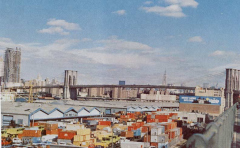
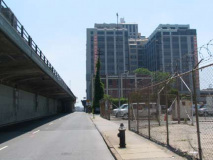
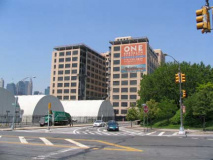
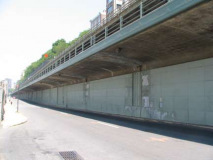
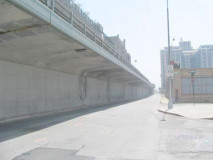
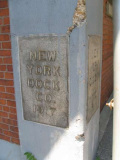
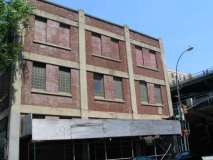
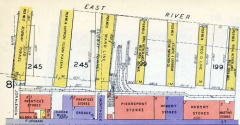
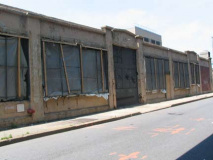
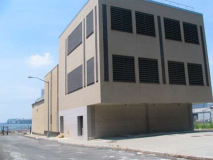
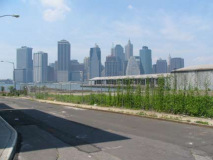
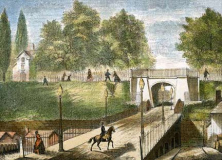
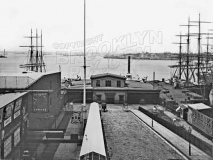
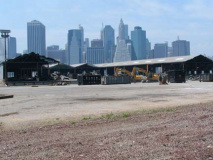
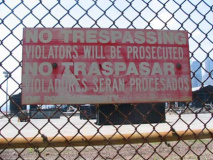
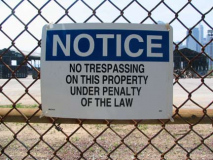
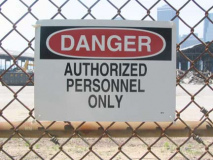
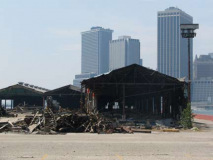
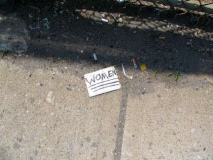
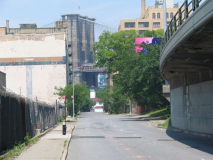
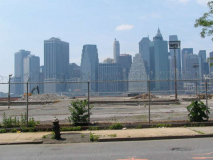
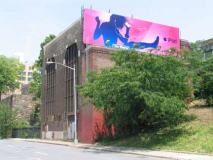
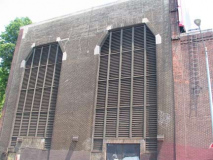
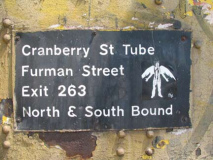
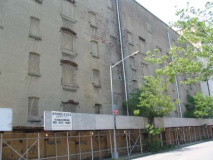
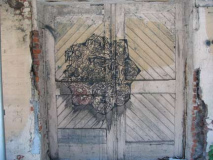
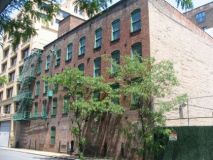
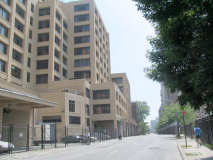
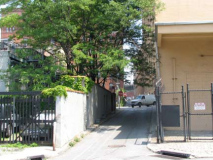
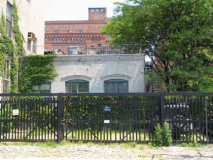
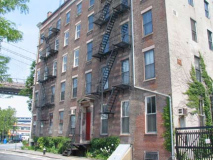
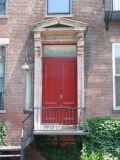
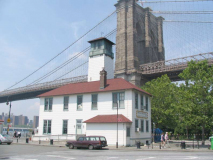
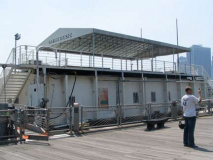
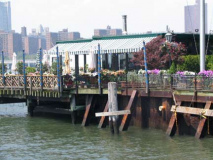

1 comment
[…] kayaked off of Valentino Pier in Red Hook. I’ve taken my bike for a ride downtown and returned via Furman St, a quiet artery that runs under the BQE along the water, before there was a new park right alongside […]
Comments are closed.